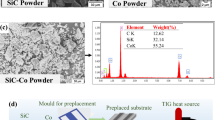Abstract
The work “The Mechanism of Wear Process of Cobalt-Carbide” shows the result of studying cemented carbide when machining refractory alloys based on chromium (X65HBΦT) and nickel (XH77TУP). The conducted research has shown that the machining of chromium-based alloy with a more heat-resistant process of the wear of the carbide inserts with or without a nanoscale coating occurs less intensively than for the tool wear process in the machining of Ni alloy It is established that this effect is connected with different crystal structures, phase contents, and properties of the heat-resistant alloys in question.
Similar content being viewed by others
References
Grigoriev, S.N., Metel, A.S., and Fedorov, S.V., Modification of the structure and properties of high-speed steel by combined vacuum-plasma treatment, Metal Sci. Heat Treat., 2012, vol. 54, pp. 8–12.
Sobol’, O.V., Andreev, A.A., Grigoriev, S.N., Volosova, M.A., and Gorban’, V.F., Vacuum-arc multilayer nanostructured TiN/Ti coatings: structure, stress state, properties, Metal Sci. Heat Treat., 2012, vol. 54, pp. 28–33.
Stroenie i svoistva aviatsionnykh materialov (Structure and Properties of Aviation Materials), Belov, A.F., Ed., Moscow: Metallurgiya, 1989.
Filatov, P.N., Increasing of durability of drawling tool from powder high-speed steel at heat-resistant nickel alloy treatment, Vestnik MGTU “Stankin”, 2008, no. 4, pp. 44–50.
Maslov, A.R., Measurement of the roughness parameters of a treated surface in turning parts fabricated from heat-resistant alloys, Measur. Techn., 2012, vol. 55, pp. 648–653.
Marochnik stalei i splavov (Marker of Steels and Alloys), Sorokin, V.G., Ed., Moscow: Mashinostroenie, 1989.
Poduraev, V.N., Rezanie trudnoobrabatyvaemykh materialov (Cutting of Intractable Materials), Moscow: Vysshaya Shkola, 1974.
Grigoriev, S.N., Fominskii, V.Yu., and Gusarov, A.V., Features of microand nanostructures of Au-Ni alloys obtained on nickel due to different modes of pulse laser alloying, Metal Sci. Heat Treat., 2012, vol. 54, pp. 34–40.
Vereshchaka, A.S., Kirillov, A.K., Sotova, E.S., and Dacheva, A.V., High-strength ceramic composite with nanostructural coating in environmentally benign dry cutting with compensation of lubricant properties, Russ. Eng. Res., 2010, vol. 30, pp. 1074–1076.
Adaskin, A.M., Kremnev, L.S., and Sapronov, I.Yu., Fracture of ledeburite and hypereutectoid high-speed steels, Metal Sci. Heat Treat., 2011, vol. 53, pp. 280–284.
Fel’dshtein, E.I., Obrabatyvaemost’ stalei (Steel Machinability), Moscow: Mashgiz, 1953.
Volosova, M.A. and Kuzin, V.V., Regular features of wear of cutting plates from oxide and nitride ceramics, Metal Sci. Heat Treat., 2012, vol. 54, pp. 41–46.
Kirillov, A.K., Vereshchaka, A.S., Kozlov, A.A., and Robakidze, Z.Yu., Dry cutting of hard-to-machine materials, with compensation of the physical functions of the lubricant and coolant fluid, Russ. Eng. Res., 2009, vol. 29, pp. 433–437.
Kremnev, L.S., Alloying theory and its use for creation of heat-resistant tool steels and alloys, Metal Sci. Heat Treat., 2008, vol. 50, pp. 526–534.
Kisel’, V.M., Evdokimov, Yu.I., Frolov, G.A., and Buchakov, S.V., Infliction of intermetallide Ni-Al compound coatings by high-speed air-combustive infliction method, Aviats.-Kosmich. Tekhn. Tekhnol., 2009, vol. 67, pp. 50–54.
Lifshits, B.G., Kraposhin, V.S., and Linetskii, Ya.L., Fizicheskie svoistva metallov i splavov (Physical Properties of Metals and Alloys), Moscow: Metallurgiya, 1980.
Khimicheskaya entsiklopediya, v 5 t. (Chemical Encyclopedia in 5 vols.), Zefirov, N.S., Moscow: Bol’shaya Rossiiskaya Entsiklopediya, 1999, vol. 5.
Zinov’ev, V.E., Teplofizicheskie svoistva metallov pri vysokikh temperaturakh. Sprav. (Thermophysical Properties of Metals at High Temperatures. A Handbook), Moscow: Metallurgiya, 1989.
Author information
Authors and Affiliations
Corresponding author
Additional information
Original Russian Text © A.M. Adaskin, A.A. Vereshchaka, A.S. Vereshchaka, 2013, published in Trenie i Iznos, 2013, Vol. 34, No. 3, pp. 277–283.
About this article
Cite this article
Adaskin, A.M., Vereshchaka, A.A. & Vereshchaka, A.S. Study of wear mechanism of hard-alloy tools during machining of refractory alloys. J. Frict. Wear 34, 208–213 (2013). https://doi.org/10.3103/S1068366613030021
Received:
Published:
Issue Date:
DOI: https://doi.org/10.3103/S1068366613030021




